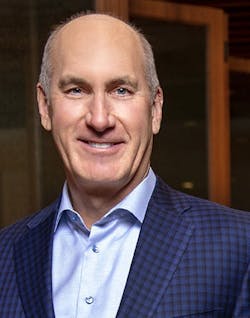AT&T’s CEO: Owning 5G and fiber networks drives broadband and mobile market share
As AT&T scales its fiber broadband network to more locations, it can enhance its reach by helping existing wireless customers migrate to fiber services.
Speaking to investors during AT&T's second-quarter earnings call, John Stankey, president and CEO, said the telco’s broad set of wireless and wireline fiber assets gives it a competitive advantage.
“In our Fiber business, we continue to achieve key penetration milestones faster than we anticipated and considerably quicker than the fiber providers that do not operate wireless networks based on publicly available data,” he said. “A key reason for this strong performance is our ability to sell fiber to our mobile customers.”
Stankey added that it can pursue new broadband customers via its sizeable mobile distribution channel within its traditional wireline footprint and in markets it will reach via its Gigapower venture.
“The key point here is that our proven ability to drive higher share in mobility and broadband through converged service penetration is the true benefit of owning and operating both 5G and fiber networks at scale,” he said. “While our convergence strategy began with a focus on our fiber footprint, we also see attractive opportunities to expand the availability of AT&T Fiber in our converged offers outside of it.”
Scaling Gigapower
Besides offering fiber-based services to residential and business customers outside its footprint, AT&T sees an opportunity to provide converged wireless services via its Gigapower venture.
Gigapower is an open-access fiber network offering wholesale fiber services to other ISPs nationwide in parts of select metro areas.
Gigapower enables AT&T to expand its fiber service reach beyond its traditional service areas and deliver state-of-the-art broadband access technologies to more communities across the country.
Stankey said its ongoing fiber build and the Gigapower venture will allow AT&T to enhance its converged wireless and wireline broadband strategy.
“We expect the continued expansion of AT&T's fiber, both within its footprint and outside of it, to enable us to drive significant growth with converged customers,” he said.
Since the Gigapower back-office infrastructure supports wholesale arrangements with other providers, it could help them market its fiber and wireless products. Stankey sees this as a way to further differentiate AT&T from others that don’t have wireless assets.
“We view that as a beneficial dynamic for somebody trying to get scale,” Stankey said. “So, I see further runway and opportunity for us to do more. You should expect that as we move forward and continue this race to convergence. It's one of the tools we will use to put distance between ourselves and everybody else.”
Fiber broadband rising
Fiber broadband was a key highlight of AT&T’s second-quarter results as the telco reported a substantial uptick in fiber additions.
AT&T added 239,000 AT&T Fiber net subscribers during the second quarter, marketing over 200,000+ net adds for 18 consecutive quarters. Fiber ARPU of $69 was up $2.30 year-over-year, with intake ARPU remaining above $70.
It also added 139,000 new AT&T Internet Air subscribers.
The ongoing fiber returns helped drive AT&T’s Consumer Wireline growth of 7% yearly to $2.7 billion. AT&T noted that consumer Wireline revenues rose 3% year over year, driven by broadband revenues attributable to fiber revenues, which grew 17.9%, partially offset by declines in legacy voice and data services and other services.
Consumer Wireline EBITDA grew 7.1% as growth in broadband revenues and ongoing cost transformation continued to improve profitability. We still expect Consumer Wireline EBITDA to grow in the mid to high single-digit range this year.
“In consumer wireline, we added broadband subscribers for the fourth consecutive quarter, driven by consistent growth in AT&T Fiber and early success with AT&T Internet Air,” Stankey said. “This story is about growing customers and profitability as our consumer wireline business delivered more than 7% EBITDA growth during the second quarter.”
Looking forward, AT&T maintains that it is on track with its fiber deployment plans. The service provider has reached nearly 28 million consumer and business locations and expects to surpass 30 million locations by the end of 2025.
Pascal Desroches, CFO of AT&T, said that its fiber build results drive it to consider extending fiber to more locations not included in its initial build-out plan.
“As we've stated before, the better-than-expected returns we're seeing on our fiber investments potentially expand the opportunity to go beyond our initial build targets by roughly 10 to 15 million additional locations,” he said. “This assumes similar growth parameters and a regulatory environment that remains attractive to building infrastructure.”
He added, “We are also encouraged by AT&T Internet Air's early performance and our success in proactively migrating customers with legacy copper-based Internet connections onto this fixed wireless service.”
From an overall financial perspective, AT&T reported revenues were $29.8 billion versus $29.9 billion in the year-ago quarter, down 0.4%. The telco said this decline was due to lower Business Wireline service revenues and declines in Mobility equipment revenues driven by lower sales volumes.
For related articles, visit the Broadband Topic Center.
For more information on high-speed transmission systems and suppliers, visit the Lightwave Buyer’s Guide.
To stay abreast of fiber network deployments, subscribe to Lightwave’s Service Providers and Datacom/Data Center newsletters.

Sean Buckley
Sean is responsible for establishing and executing the editorial strategies of Lightwave and Broadband Technology Report across their websites, email newsletters, events, and other information products.


